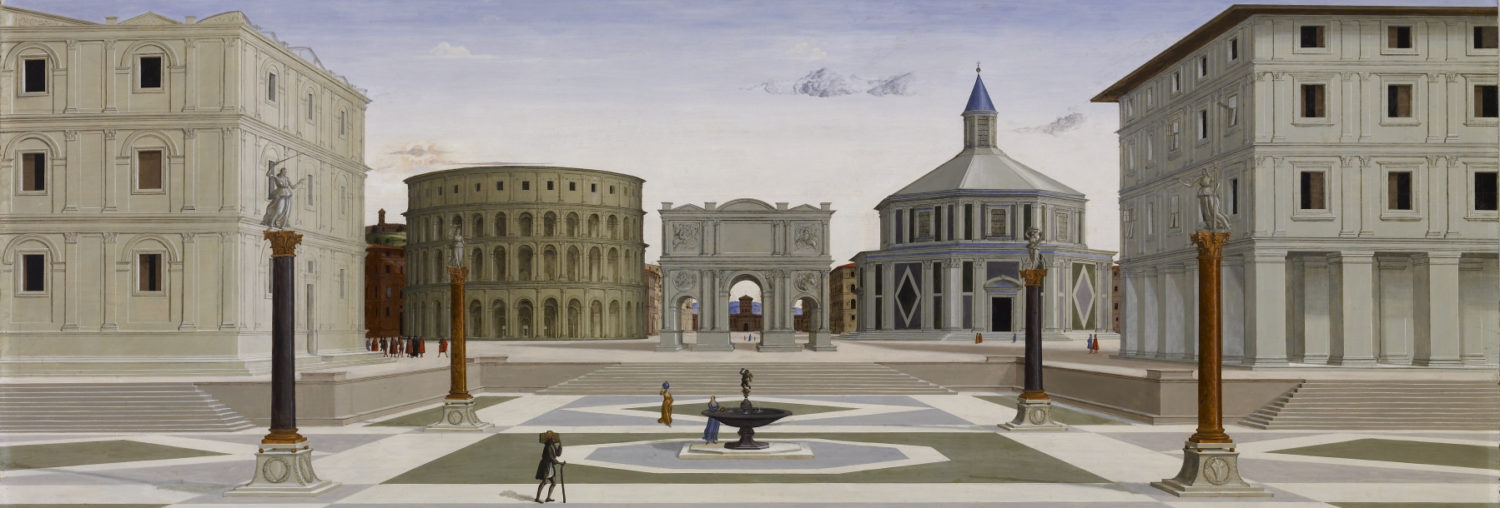
This view is an engraving. It was made in 1586 by Dutch artist Joris Hoefnagel. The view was placed in the sixth volume of atlas of world’s cities ”Civitates Orbis Terrarum”, published in Cologne by Georg Braun and Frans Hogenberg. Warsaw is the capital of Poland and masovian voivodeship. The metropolis stands on the Vistula in east-central Poland. The vecinity of Warsaw was formed by glacial processes. The significant element of landform, undercut from the east by Vistula, is the edge of moraine plateau called Warsaw Escarpment.
The city rose at the turn of 13th and 14th centuries and it was located under the Chełmno Law. However the location document has not preserved. The prince Bolesław II, who is considered the founder, brought from Toruń the group of wealthy merchants. They were lokators and they named the city Warszowa. This early form derived from the name of knight Warsz from Rawicz family. The construction of the city began from creating specific urban layouts dependent on topographical conditions, inhabitants’ needs and size of the main square. The plan was created by professionals and it is typical for cities located under German law. City boundaries and the place for church were demarcated and symmetry of city plan was accepted. The wealthy lokators made the city was surrounded by walls from the land quite early. Demarcated main square was relatively small because no big hopes were placed on city’s development. Two perpendicular streets ran out from its corners. The longer side was parallel to Zakroczym-Czersk Way, which was the most important way in the city. 40 building lands were
demarcated around the main square.
The main square had a functions of as agora and meeting place. There was a mayor’s house too. The gothic town hall, which was the City Council’s office, was built at the beginning of the 15th century. With the founding of the city, the St. John’s parish church was established. Over the years the Warsaw’s economic and political significance was growing. A special rise took place under the reign of Prince Janusz I the Elder who established Warsaw as the capital of the Duchy of Masovia. The city was enclosed with a double wall topped with towers and protected by a moat. A gothic building, the seat of a Prince, was on the escarpment. It was built in 15th century and was called the Great House. There were courts and a chancellery next to it. The St. Martin’s church and monastery and the Holy Spirit’s Hospital for poor old people were built near the western part of the walls. Within the walls were: a prison in the Marszałkowska Tower, two cemeteries at the back of parish church and the bath near the Nowomiejska Gate. The burgher houses were initially wooden but later they were replaced with brick ones. At the beginning of the 14th century to the north of the Old Town, the New Town came into existence. It was inhabited mainly by craftsmen and merchants. The city was not limited by walls and it was founded on regular plan with main square in the center. Two buildings were distinguished: the St. George’s church and monastery and completed in 1411 church of Blessed Virgin Mary. In the mid-fifteenth
century Princess Anna founded St. Anne’s church and the bernardine monastery.
An important event in taking over the privileges of other Masovian towns by Warsaw was the end of the Duchy of Płock. In 1529 a general sejm took place here. In the second half of the 16th century Warsaw took over the role of place of royal elections. In 1568 the construction of a wooden bridge over the Vistula began as on the initiative of Zygmunt August and Anna Jagiellonka. Previously, there was the ferry crossing or people were building temporary bridges. However, the frequent visits of the king in the city and choosing Warsaw as a place of parliaments initiated the construction of probably the largest wooden structure in Europe. The construction was managed by Erazm Giotto, a burgher from Zakroczym. A work was supervised by Zygmunt Wolski, a Warsaw starost and the priest Kasper Sadłocha was responsible
for finances. The construction was completed in 1573. The Bridge Gate was on the abutment. The bridge has served residents and visitors for 30 years, was demaged several times by Vistula, until it finally collapsed. In those days it had to make a great impression on the people because Jan Kochanowski wrote a few epigrams about it.
Monika Górowska tutored by Dr Natalia Bursiewicz
